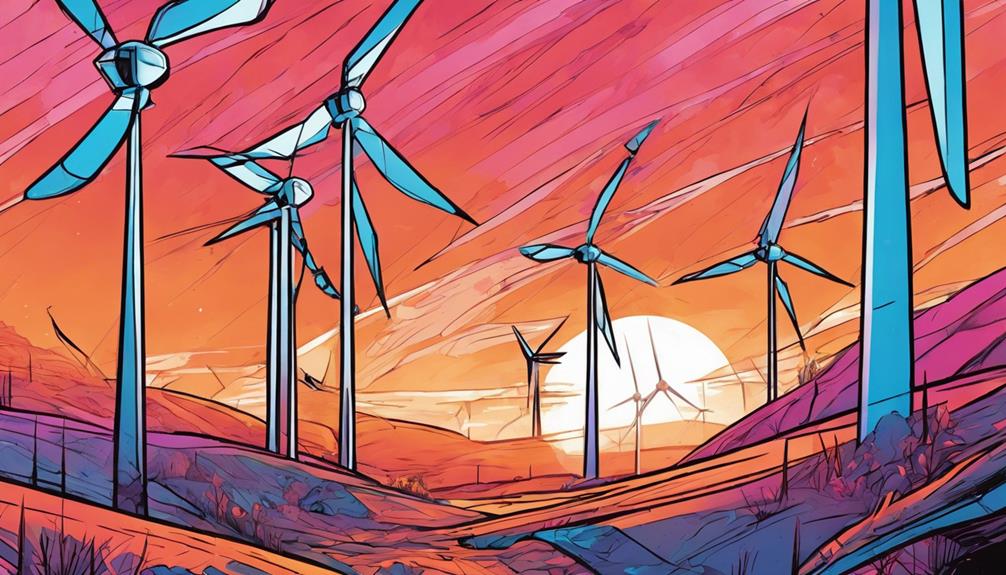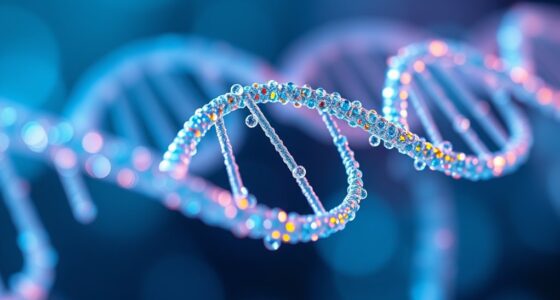As you explore the world of wind energy, you'll find that turbine speed is vital for maximizing energy production. Even slight changes in rotation speed have a substantial impact on the amount of electricity generated. Peak turbine speed, combined with advanced blade designs and increased hub height, can enhance electricity generation. Newer turbines are capable of producing an average capacity of 3.2 megawatts, indicating advancements in energy production. To fully grasp the complexities of wind energy, you'll want to examine the dynamics of turbine design, rotation, and performance, as well as the industry's future potential to shape the global energy landscape.
Key Takeaways
- Turbine speed is crucial for maximizing energy production, with optimizing speed and blade design being essential for efficient electricity generation.
- Rotation speed significantly impacts power generation, with pitch control, variable-speed systems, and hub height also affecting energy production.
- Newer turbines with increased hub height and advanced blade designs can enhance electricity generation, with average capacities reaching 3.2 megawatts in 2022.
- Anemometry and Laser Doppler vibrometry (LDV) are used to measure turbine speed for evaluation purposes, ensuring optimal performance and energy capture.
- Maximizing turbine speed and efficiency is critical for achieving the future potential of wind energy, which could supply nearly half of the world's electricity needs by 2050.
Uncovering Wind Turbine Secrets
As you explore the world of wind turbines, you'll discover that the key to maximizing energy production lies in optimizing turbine speed, which can reach incredible rates of up to 80 meters per second in advanced models.
To achieve this, wind turbine designers focus on blade design, which plays an essential role in capturing wind energy. The average hub height of offshore wind turbines has increased, allowing them to harness more power from the wind. This, combined with advanced blade designs, enables turbines to generate more electricity. The result is a significant increase in wind turbine nameplate capacity, with newly installed turbines reaching an average capacity of 3.2 megawatts in 2022.
As you explore further, you'll find that optimizing turbine speed is just one piece of the puzzle. Factors like wind conditions and mechanical adjustments also impact turbine rotation speeds, making accurate speed measurement methods essential for evaluating turbine performance and efficiency.
The Science of Wind Energy

You're about to uncover the fascinating science behind wind energy, which relies on the intricate dance of turbine blades, rotors, and towers working in harmony to harness the power of the wind.
As you explore into the world of wind energy, you'll discover that turbines generate electricity by converting wind kinetic energy into mechanical energy, which is then converted into electrical power. The rotation speed of turbines, ranging from 6 to 55 mph, is essential for efficient power generation.
Advanced technologies like pitch control and variable-speed systems optimize turbine efficiency and performance. To accurately evaluate turbine performance, measurement methods like anemometry and LDV are used to calculate turbine speed.
Factors like hub height, rotor diameter, and nameplate capacity have a significant impact on the speed and energy production of wind turbines. By understanding these intricacies, you'll appreciate the remarkable technology behind wind energy, where every detail counts in harnessing the power of the wind.
Turbine Types and Designs

Explore the diverse range of turbine designs, from the traditional Horizontal Axis Wind Turbines (HAWT) to innovative Vertical Axis Wind Turbines (VAWT), each engineered to maximize energy capture. You'll find that turbine types and designs vary significantly, catering to different wind speeds and energy generation needs.
Here are some key differences:
- Rotor diameter: Larger rotors, like those found in offshore wind farms, capture more energy from slower wind speeds.
- Turbine height: Taller turbines, like those used onshore, can reach stronger, more consistent wind speeds.
- Rotation speed: Commercial turbines withstand wind speeds up to 70 meters per second, with some models reaching 80 meters per second.
- Technology advancements: Newer turbines feature larger rotors, averaging over 130 meters in diameter, to increase electricity production.
As you delve into the world of wind turbines, it's essential to understand the unique characteristics of each design. By doing so, you'll gain insight into how these incredible machines harness the power of wind to generate clean energy.
Speed and Rotation Dynamics

Now that you've explored turbine types and designs, it's time to examine the intricacies of speed and rotation dynamics.
You'll discover how rotor speed control and blade rotation dynamics work together to optimize wind energy harnessing.
As you explore these key aspects, you'll gain a deeper understanding of what makes wind turbines efficient and effective.
Rotor Speed Control
By dynamically adjusting blade pitch, wind turbines can expertly regulate their rotor speed to optimize energy production and efficiency. This process, known as rotor speed control, is essential for maximizing energy capture and ensuring operational safety.
Here are some key factors that contribute to effective rotor speed control:
- Blade pitch adjustment: Adjusting the angle of the blades to control rotor speed and optimize energy production.
- Variable-speed technology: Enabling wind turbines to adjust rotation speed for improved performance and noise reduction.
- Blade design optimization: Vital for maximizing energy capture and enhancing rotor speed control.
- Power regulation mechanisms: Monitoring and adjusting turbine output to maintain safe and efficient operation, preventing damage from excessive power levels.
Blade Rotation Dynamics
As you explore the intricacies of wind turbine operation, you'll discover that blade rotation dynamics, specifically the speed and rotation dynamics, play a critical role in determining energy production and efficiency.
The speed at which turbine blades rotate can range from 6 to 55 mph, with commercial turbines designed to withstand up to 70 meters per second for survival. Blade tip speed, in particular, is essential in determining energy production and efficiency.
Factors like wind conditions, turbine design, and blade size all influence the rotation speeds of wind turbines. For instance, larger blades can capture more energy, but may require slower rotation speeds to maintain efficiency.
Wind turbine technicians are essential in regulating and optimizing turbine speeds to guarantee maximum efficiency and safety. To accurately measure blade speeds and evaluate turbine performance, methods like anemometry and laser Doppler vibrometry are used.
Turbocharging Wind Power

To maximize energy production, you can turbocharge wind power by fine-tuning blade design, wind conditions, and mechanical adjustments to boost rotation speeds. By optimizing these factors, you can increase the efficiency of your turbines and generate more electricity.
Here are some key factors to take into account:
- Rotor diameter: A larger rotor diameter allows for more efficient energy capture, with newly installed turbines in 2022 averaging over 130 meters in diameter.
- Hub heights: Taller hub heights can capture stronger and more consistent winds, with land-based turbines increasing in height by 73% since 1998-1999 to approximately 98 meters in 2022.
- Wind speed: Wind turbines can handle wind speeds ranging from 6 to 55 mph, with some models capable of handling speeds up to 80 meters per second.
- Mechanical adjustments: Fine-tuning mechanical components, such as gearboxes and generators, can also help boost rotation speeds and energy production.
Controlling Turbine Rotation

You enhance wind turbine performance by managing rotation speed, which involves adjusting blade pitch, leveraging variable-speed technology, and regulating power output to guarantee safe and efficient operation.
By adjusting the angle of turbine blades through blade pitch control, you can regulate rotation speed for peak efficiency and safety. Variable-speed technology enables turbines to adjust rotation speed for improved performance, noise reduction, and energy capture. Additionally, power regulation mechanisms monitor and adjust power output to secure safe and efficient turbine operation, preventing damage from high power levels.
To promote top-notch turbine efficiency, it's crucial to take into account factors like wind conditions, turbine design, blade size, wind strength, and terrain, all of which influence turbine rotation speeds. By implementing accurate speed measurement methods like anemometry and laser Doppler vibrometry, you can evaluate turbine performance and efficiency, making adjustments as needed to maximize energy production.
Measuring Turbine Performance

Measuring turbine performance accurately is essential to optimizing energy production. It starts with employing precise methods to evaluate rotation speed and airflow dynamics. You need to understand how air speed changes, vibration measurements, and flow patterns impact turbine performance.
To do so, various methods are employed:
- Anemometry: Measures air speed changes around turbines using pressure devices, providing vital data for evaluating turbine performance.
- Laser Doppler vibrometry (LDV): Calculates blade speed through vibration measurements, aiding in monitoring and enhancing turbine efficiency.
- Flow visualization: Analyzes flow patterns around turbines using high-speed cameras, offering insights into airflow dynamics for performance evaluation.
- Accurate speed measurement methods: Essential for evaluating turbine efficiency and ensuring effective power generation.
Wind Energy's Future Potential

As wind energy's popularity surges, its future potential looks brighter than ever, with projections suggesting it could supply nearly half of the world's electricity needs by 2050.
You might be wondering, what does this mean for the industry's growth? The answer is significant. By 2050, the wind industry could employ over six million people globally, showcasing its job creation potential.
Research emphasizes that wind power deployment is essential for driving global transformation in energy generation. With ongoing innovations and advancements in wind technology, the capacity for low-cost, sustainable electricity production is vast.
Onshore wind capacity is expected to increase, while offshore wind farms will play an important role in harnessing renewable energy.
As global wind power continues to expand, it's becoming clear that wind energy has the potential to become the world's foremost generation source, contributing substantially to energy needs. With technological advancements paving the way for sustainable energy, the future of wind energy looks brighter than ever.
Frequently Asked Questions
How Is Power Generated by Using the Wind Speed to Turn Turbines?
You harness wind energy by leveraging wind speed to turn turbines, which converts kinetic energy into electricity, and you're doing it by attaching blades to a rotor that spins a generator, producing power as the turbine rotates.
What Is the Future for Wind Turbines?
You're wondering what the future holds for wind turbines. Well, by 2050, you'll see a massive growth in wind power capacity, with Asia leading the way, creating millions of jobs and driving down energy costs.
Does the Power Generated Affect the Speed of the Wind?
You might be surprised to know that a single wind turbine can power over 1,400 homes! Now, to answer your question, no, the power generated by wind turbines doesn't affect the speed of the wind.
What Is the Speed of a Wind Turbine?
You're wondering what speed a wind turbine operates at – well, they typically rotate between 6 to 55 mph, depending on design and wind conditions, with commercial turbines capable of withstanding up to 80 meters per second.
Conclusion
As you've seen, understanding the speed of wind turbines is essential for harnessing wind energy efficiently. Remember, 'knowledge is power,' and now you have the ability to reveal the secrets of wind turbines.
With the science, designs, and dynamics behind wind energy, you're equipped to accelerate the future of sustainable power. As the world shifts towards renewable energy, your newfound understanding will help drive the change, making a significant impact on our planet's future.










